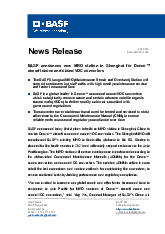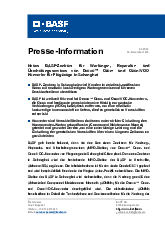BASF announces new MRO station in Shanghai for Deoxo™ aircraft ozone and ozone/VOC converters
- The BASF Shanghai MRO (Maintenance Repair and Overhaul) Station will support customers in Asia Pacific with high quality maintenance service and faster turnaround time
- BASF is a global leader in Deoxo™ ozone and ozone/VOC converters which catalytically remove ozone and certain odorous volatile organic compounds (VOCs) to deliver quality cabin air compliant with government regulations
- The converters are rotable parts and must be tested and serviced in strict adherence to the Component Maintenance Manual (CMM) to ensure reliable performance and regulatory compliance over time
BASF announced today that it plans to build an MRO station in Shanghai, China to service Deoxo™ aircraft ozone and ozone/VOC converters. The Shanghai MRO will complement BASF’s existing MRO in Huntsville, Alabama in the US. Startup is planned for the fourth quarter in 2021 and will mainly support customers in the Asia Pacific region. The MRO station will ensure maintenance is performed according to the Abbreviated Component Maintenance Manuals (ACMMs) for the Deoxo™ ozone converters and ozone/VOC converters. The updated ACMMs define in more detail the test procedures and service methods for maintaining the converters, to ensure continued industry-leading performance and regulatory compliance.
“We are excited to increase our global reach and offer faster turnaround time to customers in Asia Pacific for MRO services of Deoxo™ aircraft ozone and ozone/VOC converters,” said Ying Wu, General Manager of BASF’s Clean Air Business. “We are committed to support our customers and help ensure clean aircraft cabin air quality for everyone.”
During flight, airplanes at high altitudes are exposed to significant levels of ambient ozone. If unabated, the ambient ozone enters the aircraft cabin through the air conditioning ducts. Prolonged exposure to ozone at concentrations typical of these altitudes is known to cause adverse health effects including headaches, fatigue, shortness of breath, chest pains, coughing, and irritation of the eyes, nose or throat.
During ground and taxiing operations, odorous VOCs can enter the aircraft cabin through the bleed air system. These VOCs may include exhaust fumes from jet engines on neighboring airplanes, exhaust fumes from airplane service vehicles and de-icing fluids. Engine oil and hydraulic fluids may also leak into the bleed air system. These odorous VOCs may result in crew and passenger discomfort or even alarm, precipitating aircraft diversions and delays.
BASF’s Deoxo™ ozone/VOC dual function converters catalytically remove ozone and certain odorous VOCs to deliver better quality cabin air. They are available for factory installation on new airplanes or as a field retrofit for airplanes already in service that either don’t have an ozone converter or would benefit from the performance upgrade from an existing Deoxo™ ozone converter.
BASF is the leading supplier of proven ozone and ozone/VOC catalytic converter technologies addressing the needs of aircraft OEMs to achieve compliant and comfortable cabin air quality for crew and passengers. We pioneered the first ozone converter over 30 years ago, and our ozone/VOC dual-function converter has been used on aircraft for over 15 years.
MRO service is available through BASF’s global distribution network.
At BASF we create chemistry for a sustainable future and develop innovative solutions that ensure the long-term success of our customers.
Deoxo is a trademark of BASF
Receive up-to-date news releases from BASF via push notification on your smartphone. Register for our news service at basf.com/pushnews.




